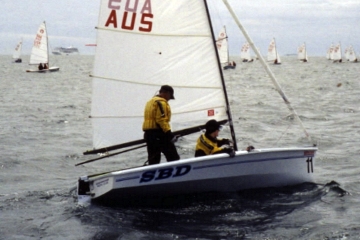There are four modes of sailing. Displacement mode, forced mode, planing, and the 4th mode. Obviously many ocean sailboats do not plane and hence there is no reason to learn sail planing techniques on those boats. In fact it is just the opposite. There are good reasons to learn how to prevent planing on displacement hulled sailboats – or any displacement vessel for that matter. This is because planing a displacement-hull vessel will put dangerous stresses on the hull and if a sailboat, on the rigging. If the vessel is not designed for planing, hull folding, dismasting, boom failure, etc is possible.
In contrast, when the boat is designed for planing, the hull will break out of the water revealing the stresses. There is also no reason to learn about 4th mode on a displacement sail boat. Displacement sailboats are too heavy to make this mode of sailing, which involves moving weight forward. In a displacement sailing vessel, recognizing forced mode is important for speed. Forced mode is when the boat is climbing its own bow wake. Planing happens when the bow wake is crested.
Is it any wonder that US trained crews are not competitive in the Americas Cup and Around Alone? Those crews have learned but 1/4 of what is necessary to be competitive, or at least those in charge have learned only 1/4 of what is necessary.

Many do not know that the highest paid athletes in the world are sailors. But US sailors are not well respected. In 2003 the World Tasar championships were swept by US athletes desperate to earn the kind of respect given sailor athletes in other countries. The Tasar is a Bethwaite Design and utilizes a rotating mast like multihulls. Unfortunately, a decade later, it is rare to find a US trained crew member on a competitive boat.
Why US Sailing?
US Sailing has been re-inventing itself. Its management consultants pointed out that sailing in the US is considered by many to be an elite activity, aloof from the rest of society and thereby undesirable. This the management consultants proposed partially explained the net loss of 100,000 US sailors to the sport each year and low interest in membership in 2007.
US Sailing is de-emphasizing support for the elite racers, such as TP52s, owner driver classes, and large one-designs, and is attempting to grow the sport through support of production cruisers such as Catalina’s and Macgregors. They also are more open about elections of board members and even let members vote for who will become a board member!
This membership voting is a big change for US Sailing. Members have not yet been part of the board selection process at US Sailing. This had been done from the top down, not bottom up. The rational for that was the feeling that if you let members vote for board positions you might get a “bad” board member.
The notion that an election can give a bad result is such a politically charged one that US Sailing really could no longer support its old board selection process and expect US government funding or non profit status. The risk of getting a “bad” board member with the top down approach might now be considered greater because so many selected that way have had duties outside those of the board that have overwhelmed them or clouded their board decisions.
US Sailing has now implemented a modern structure. It may take a decade, but we can expect the US trained to find positions on competitive race crews as the courses are modernized.
[ipic id=”442200033788941423″]



11 thoughts on “Planing vs Displacement Sailing”